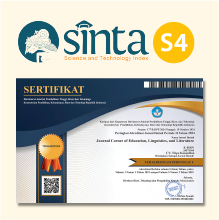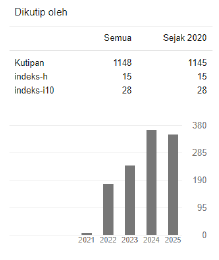The Use of Drilling Technique to Teach English Speaking to the Early Childhoods: A Descriptive Study
 https://doi.org/10.54012/jcell.v2i1.66
https://doi.org/10.54012/jcell.v2i1.66
 Abstract views: 2836
Abstract views: 2836
 PDF downloads: 1291
PDF downloads: 1291
Keywords:
drilling technique, teaching English speaking, the early childhoodAbstract
Teaching English speaking to the early childhoods requires optimal efforts and special tricks. The teacher requires appropriate teaching technique and media to make them enjoy during learning English speaking. This research attempts to report what appropriate technique and media applied by the teacher during teaching English speaking to the early childhoods in one of English courses in Ciamis - West Java. In this research, the researchers set forth two research questions, they are what teaching technique is appropriately applied to teach English speaking to the early childhoods? And what media are suitable to teach English speaking to the early childhoods? To answer the aforementioned research questions, the researchers employ a qualitative descriptive study at which they observe the process of teaching and learning English towards a group of the early childhoods during February - June 2019. The results of the research reveal that drilling is selected as the appropriate technique under the Audio-Lingual Method applied by the teacher during teaching English speaking to the early childhoods. Meanwhile, song is selected as the appropriate media applied by teacher during teaching English speaking to the early childhoods. In conclusion, through employing drilling technique and song, the process of teaching English speaking to early childhoods becomes more fun, so that their English speaking skill is improved.
Downloads
References
Aini. N., Khoyimah, N., & Santoso, I. (2020). Improving students speaking ability through repetition drill. Project: Professional Journal of English Education, 3(1), 26-35. http://dx.doi.org/10.22460/project.v3i1.p26-35.
Brown, H.D. (2007). Principals of language learning and teaching, fourth edition. United States of America: Pearson Education Inc.
Celce-Murcia, M. (2001). Teaching English as a second or foreign language. United States of America: Heinle & Heinle, a division of Thomson Learning, Inc.
Creswell, J.W. (2012). Educational research: Planning, conducting and evaluating quantitative and qualitative research, fourth edition. Boston, MA: Pearson.
Dalman, Hesti, & Apriyanto, S. (2020a). Conversational implicature: A pragmatic study of “our conversation” in learning at university. International Journal of Psychosocial Rehabilitation, 24(8), 4332–4340.
Dalman, Hesti, & Apriyanto, S. (2020b). Conversational implicature: A pragmatic study of “our conversation” in learning at university. International Journal of Psychosocial Rehabilitation, 24(8), 4332–4340. https://doi.org/10.37200/IJPR/V24I8/PR280450
Fraenkel, J.R., Wallen, N.E., Hyun, H.H. (2012). How to design and evaluate research in education, eight edition. New York: The McGraw-Hill Companies.
Halimah, H., Nurviyani, V., Saepulah, A., Helmie, J., Wandawati, R., & Mutiah, S. (2022). Virtual reality-supported drilling strategy in teaching English vocabulary to young learners. Acitya: Journal of Teaching and Education, 4(1), 88-100. https://doi.org/10.30650/ajte.v4i1.3195.
Harmer, J. (2007). The practice of English language teaching, fourth edition. Essex, England: Pearson Education Limited.
Kasanah, U., Zaini, M., Efendi, N., Wijayanto, A., & Setyowati, E. (2022). The development of smart snake and ladder media in mastery of English vocabulary grade III at SDI Babussalam Pandean Durenan Trenggalek. Journal Corner of Education, Linguistics, and Literature (JCELL), 1(4), 216-226. https://doi.org/10.54012/jcell.v1i4.45.
Kusuma, H. A., & Apriyanto, S. (2018). Strategy on Developing English Learning Material for Specific Purposes. IJECA (International Journal of Education and Curriculum Application), 1(3), 39. https://doi.org/10.31764/ijeca.v1i3.2144
Kusumarajni, D. (2022). The effectiveness of movie for the enhancement of students' vocabulary. Journal Corner of Education, Linguistics, and Literature (JCELL), 2(1), 25-31. https://doi.org/10.54012/jcell.v2i1.51.
Mandel, L. (2001). Literacy development in the early years: Helping children read and write, 4th edition. Boston, Mass.: Allyn & Bacon.
Millington. (2011). Using songs effectively to teach English to young learners. Journal of Language Education in Asia, 2 (1), 134 - 141.
Maro, R.K. (2018). Drilling technique: A study of improving speaking skill for non-scholars in short term. English Education: Jurnal Tadris Bahasa Inggris, 11(1), 148-161.
Nassaji, H. (2015). Qualitative and descriptive research: Data type versus data analysis. Language Teaching Research, 19(2), 129–132. https://doi.org/10.1177/1362168815572747.
Nufus, T.Z. (2018). Teaching English to young learners in Indonesia (pros and cons). English Language in Focus (ELIF), 1(1), 65–70. https://doi.org/10.24853/elif.1.1.65-70.
Polrodi, S. & Gilakjani, A.P. (2021). The effect of audiolingual-based versus communicative language teaching-oriented techniques on intermediate EFL learners’ listening comprehension. LLT Journal: A Journal on Language and Language Teaching, 24(2), 493-513. https://doi.org/10.24071/llt.v24i2.3492.
Prescott, F.J. (2017). Observations from the language classroom: The importance of the group. EduLingua, 3(1), 1-18. https://www.researchgate.net/profile/Francis-Prescott/publication/324542162.
Purba, A. (2022). How first and second languages influence Indonesian students’ English as a third language: transfer and interference analysis. Elsya: Journal of English Language Studies, 4(2), 147-156. https://doi.org/10.31849/elsya.v4i2.8704.
Linse, C.T. (2005). Practical english language teaching young learners. New York: McGraw Hill Companies, Inc.
Shobikah, N. (2018). English education for early childhood learner. Jurnal At-Turats, 12(1), 50-62. https://doi.org/10.24260/at-turats.v12i1.970.
Sigirtmac, A., & Ozbek, S. (2009). Teaching English in early childhood. Journal of the Faculty of Education, 10(1), 107-122.
Stakanova, E., & Tolstikhina, E. (2014). Different approaches to teaching English as a foreign language to young learners. Procedia - Social and Behavioral Sciences, 146, 456–460. https://doi.org/10.1016/j.sbspro.2014.08.154.
Subyantoro, S., & Apriyanto, S. (2020). Impoliteness in Indonesian Language Hate Speech on Social Media Contained in the Instagram Account. Journal of Advances in Linguistics, 11, 36–46. https://doi.org/10.24297/jal.v11i.8655
The Act Number 20 of 2003 concerning the national education system.
Uysal, N.D., & Yavuz, F. (2015). Teaching English to very young learners. Procedia - Social and Behavioral Sciences, 197, 19-22. https://doi.org/10.1016/j.sbspro.2015.07.042.
Vidhiasi, D.M. (2022). The implementation of repetition and chain drill at Akademi Maritim Nusantara Cilacap. Journal Corner of Education, Linguistics, and Literature (JCELL), 2(1), 53-63. https://doi.org/10.54012/jcell.v2i1.54.
Whitehead, M. (2007). Developing language and literacy with young children, third edition. London: Paul Chapman Publishing.
Wulandari, N.L.P.T., Ratminingsih, N.M., & Ramendra, D.P. (2020). Strategies implemented in teaching English for young learners in primary school. Journal of Educational Research and Evaluation, 4(3), 235-241. https://doi.org/10.23887/jere.v4i3.26228.
Downloads
Published
How to Cite
Issue
Section
License
Copyright (c) 2022 Yusuf Hidayat, Ani Herniawati, Nu’man Ihsanda

This work is licensed under a Creative Commons Attribution-ShareAlike 4.0 International License.
All articles published in the Journal Corner of Education, Linguistics, and Literature are licensed under the Creative Commons Attribution-ShareAlike License (CC BY-SA).

















